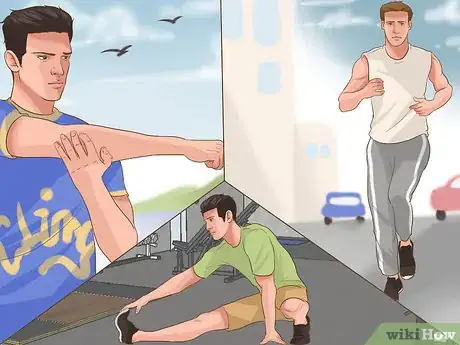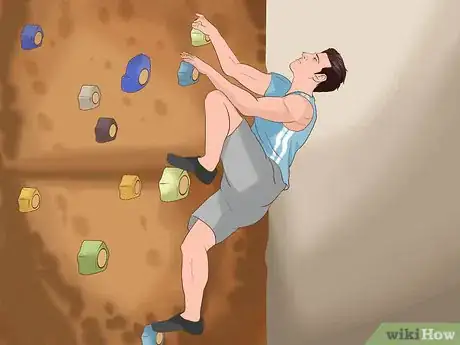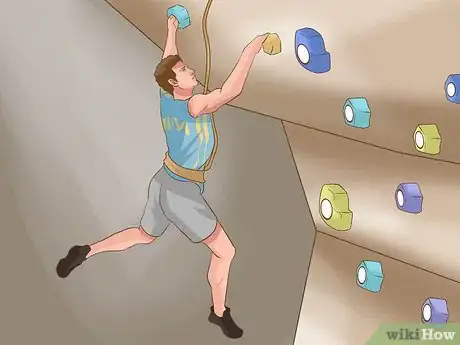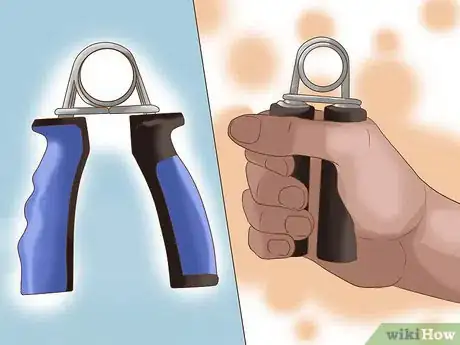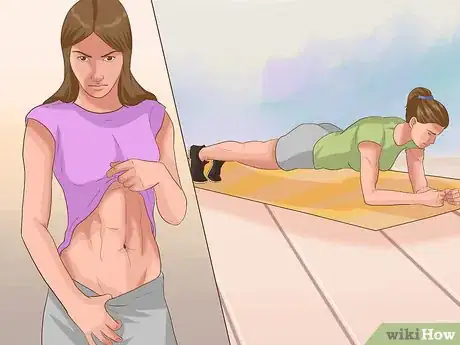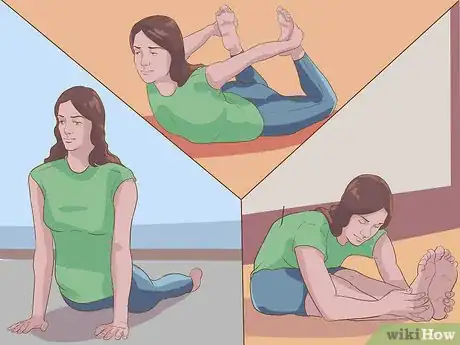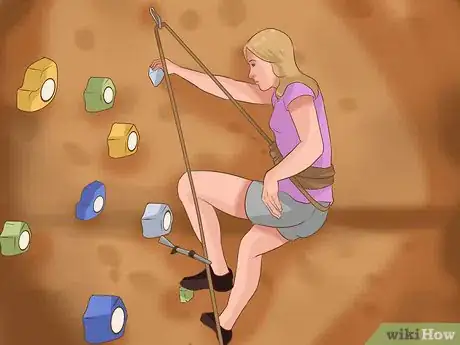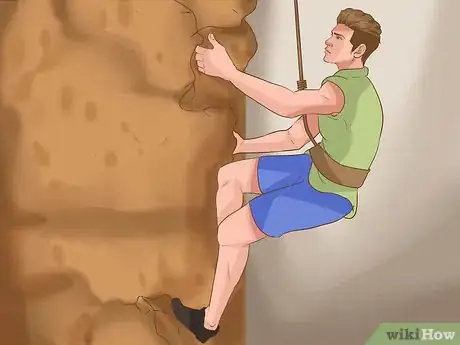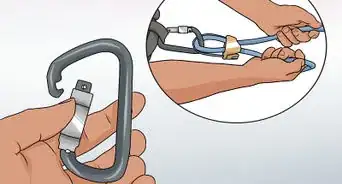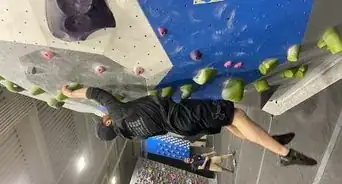This article was co-authored by Monica Morris. Monica Morris is an ACE (American Council on Exercise) Certified Personal Trainer based in the San Francisco Bay Area. With over 15 years of fitness training experience, Monica started her own physical training practice and gained her ACE Certification in 2017. Her workouts emphasize proper warm-ups, cool-downs, and stretching techniques.
wikiHow marks an article as reader-approved once it receives enough positive feedback. In this case, several readers have written to tell us that this article was helpful to them, earning it our reader-approved status.
This article has been viewed 427,809 times.
Indoor rock climbing is a challenging sport, but it is also lots of fun. If you are new to indoor climbing or if you just want to improve your skills, there are several things that you can do. You can work on mastering basic climbing skills, enhance your skills with specific techniques, or increase your strength, balance, and flexibility to prepare your body for more challenging climbs.
Steps
Improving Basic Climbing Skills
-
1Warm up before you climb. Taking time to warm up and stretch your muscles before you start a climb can help to prevent injuries. Warming up and stretching may also help to improve your performance, so it is important to start every climb with a few minutes of cardiovascular exercise and some good stretching.[1]
- Try walking briskly or jogging back and forth in the gym for a few minutes to get your blood flowing.
- Stretch your arms, shoulders, core, and legs before you start your climb.
-
2Read the route before you climb. Before you start climbing, look at the wall and try to analyze your route. Identify the best footholds and handholds, consider how you will handle difficult transitions, and plan the direction that you will take.
- Taking time to read your route is a great way to improve your climbing skills. If you do not take time to plan your route, you may end up wasting energy by having to backtrack or by having to take extra time to consider your moves.
Advertisement -
3Maintain a medium grip. Gripping too hard with your hands can wear out your forearms quickly, which may mean that you will not be able to complete your climb. To ensure that you will have enough grip strength to complete your climb, try to maintain a lighter grip on handholds.[2]
- Try to keep more of your weight on your footholds than on your handholds whenever possible.
- Try to stay close to the wall. Keeping your bodyweight closer to the wall will help to keep your body weight centered and reduce strain on your forearm muscles.[3] If you need to lean back to check your route, try to do so quickly.
-
4Make more foot movements than hand movements. Using your feet and legs to move your body upwards is more efficient than using your hands and arms, so try to make most of your movements with your feet. You should try to make three foot movements for every one hand movement.[4]
- For example, you could reach up to a high handhold and then use your feet to move your body closer to the hand hold by changing your footholds three times.
-
5Rest when you need to rest. Take a few moments to rest and regain your strength whenever you become fatigued. To rest, lean in close to the wall and use your feet to support your body weight while maintaining a light grip on your handholds.[5]
- Keep in mind that if you become fatigued, you have a higher chance of falling. Pay attention to how you feel to determine when you should rest during your climbs.
-
6Be ready to fall at any time. It is normal to falls sometimes when you are doing a climb. If you never fall, then you may not be challenging yourself enough. When you do need to fall, you will probably know and you should do certain things to make your fall as safe as possible.[6]
- Do not loop your rope around anything or any part of yourself.
- Push yourself out and away from the wall if you fall.
- Pay attention to potential holds below you.
- Put your feet up towards the wall to avoid hitting your head.
Increasing Physical Fitness for Climbing
-
1Build up your forearm muscles. Your forearms make it possible for you to grip and hold onto your handholds. If your forearms are weak, then you may not be able to hang on for long. To strengthen your grip, do exercises that target your forearm muscles.[7]
- Try getting a grip exerciser. These are handheld training devices that you squeeze with your hands to improve your grip.
-
2Train your arms and shoulders. Having good arm and shoulder strength can also make it easier for you to hold onto your handholds. To increase your arm and shoulder strength, include some pull ups and chin ups in your exercise routine.[8]
- If you can’t do a chin up or pull up yet, then include some weight training exercises that use the same movements, such as pull downs and presses.
-
3Improve your core strength. Your entire core will be engaged while you are climbing, so it is important to strengthen these muscles. You can do crunches, side crunches, planks, and other core strengthening exercises to build up your core strength.[9]
- Try holding a plank pose for 30 to 60 seconds once or twice per day.
- Do an abdominal workout a few times per week.
-
4Work on your balance. If you have poor balance, then this may make it harder for you to make certain transitions or stick on certain points as you climb. Incorporating some balance exercises into your routine can make it easier for you to handle balance-testing moments in your climbs.[10]
- Try standing on one foot in front of the climbing wall and lifting one foot in front of you. Then, point your toe and touch the tip of your toe to different footholds on the wall. Make sure that the moves are slow and controlled. Then, repeat the exercise with your other foot.
-
5Stretch your muscles. Being flexible will also help you to be a better climber, so always take time to stretch your muscles after you have trained them. You can sue a combination of yoga poses and traditional stretches to improve your flexibility. Some good stretches to use in your training routine include:
- Frog pose.
- Forward bend.
- Cobra pose.
- Shoulder and arm stretches.
- Leg Stretch
Learning New Skills
-
1Use static climbing technique. Static climbing technique emphasizes fluid movements and even weight distribution. Rather than using momentum to propel yourself upwards, you position yourself close to the wall, position your arms and legs, and then shift your body weight to the new position.[11]
-
2Incorporate dynamic climbing techniques. Dynamic climbing technique emphasizes propelling your body upwards towards a specific point that you could not otherwise reach. You will need to have strong footholds and handholds to start, but then your will use these holds to spring up towards a higher handhold.[12]
- After using dynamic techniques, you may need to dangle from the new hold for a few moments until you can steady yourself, and then find footholds to maintain your position.
-
3Try lead climbing. Lead climbing is a step up in difficulty from top rope climbing, so you may want to give it a try. With lead climbing, you do not have a rope attached to anything when you start. Instead, you clip a rope that is attached to you to different bolts along your route.[13]
- Many gyms offer classes in lead climbing that can help you to develop skills in this area. Check your local gym for upcoming classes.
-
4Observe experienced climbers. By watching experienced climbers while they climb, you can see how they handle difficult obstacles and transitions. You may also learn about new climbing techniques that you can try during your next climb.[14]
- Spend some time before or after your climbs to watch experienced climbers and make mental notes about what they do. Think about how you can incorporate these techniques and strategies into your own climb.
- Keep in mind that you may need to modify some of these techniques to suit your skill level. For example, if you want to include a dynamic technique, then you might need to start with a small leap rather than trying to launch yourself to a spot that is a few feet away.
-
5Take your training outside. Climbing on an indoor rock wall is quite different from climbing outside. After you have mastered some basic skills, you'll probably be itching to try climbing outside. The experience may provide you with some new skills that will help you with your indoor climbs.[15] You may very well become addicted to the outdoor vistas and adventure of it all.
Expert Q&A
-
QuestionHow can I get better at indoor climbing?
 Monica MorrisMonica Morris is an ACE (American Council on Exercise) Certified Personal Trainer based in the San Francisco Bay Area. With over 15 years of fitness training experience, Monica started her own physical training practice and gained her ACE Certification in 2017. Her workouts emphasize proper warm-ups, cool-downs, and stretching techniques.
Monica MorrisMonica Morris is an ACE (American Council on Exercise) Certified Personal Trainer based in the San Francisco Bay Area. With over 15 years of fitness training experience, Monica started her own physical training practice and gained her ACE Certification in 2017. Her workouts emphasize proper warm-ups, cool-downs, and stretching techniques.
ACE Certified Personal Trainer The most challenging thing with rock climbing that people neglect to realize is that the hands are going to get tired out first. So, my advice is to not use gloves when doing weight training so that you could build up the calluses that will help you.
The most challenging thing with rock climbing that people neglect to realize is that the hands are going to get tired out first. So, my advice is to not use gloves when doing weight training so that you could build up the calluses that will help you. -
QuestionDoes body awareness refer to identifying your center of gravity?
 Community AnswerYes, but it also refers to where your limbs and body are in space relative to the wall and ground.
Community AnswerYes, but it also refers to where your limbs and body are in space relative to the wall and ground. -
QuestionIs it bad to do some bodybuilding exercises for arms in addition to rock climbing? My coach said that it won't help at all. Is he right?
 Adelaide KreidelCommunity AnswerWhile strength isn’t always required for climbing, your bodybuilding exercises should help. If you do them right, you should strengthen your arms.
Adelaide KreidelCommunity AnswerWhile strength isn’t always required for climbing, your bodybuilding exercises should help. If you do them right, you should strengthen your arms.
Warnings
- If you get on a route that’s too hard for you, don't keep trying if there’s no way you’ll be able to do it; if you're hanging on the rope for longer than you’re climbing, get off. It will only frustrate your belayer and the people who are waiting to do the route. Move to a different route and come back to it once you have improved.⧼thumbs_response⧽
- Start off slowly if you are afraid of heights. Only go as high as you are comfortable, and slowly work on going a bit higher each climb. Remember that with a proper setup and halfway competent belayer you are incredibly safe. Trust your equipment. The weakest piece can support almost 2,500 lbs if used properly, and about 1,000 lbs if not. Falling injuries are rare in a gym, and seem to occur mostly when inexperienced climbers try to race each other.⧼thumbs_response⧽
- Treat injuries with respect. If you push yourself hard and pull a muscle, give it time to heal before you start working yourself again.⧼thumbs_response⧽
Expert Interview
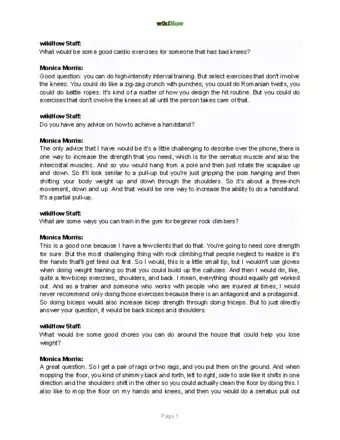
Thanks for reading our article! If you'd like to learn more about exercising, check out our in-depth interview with Monica Morris.
References
- ↑ http://www.indoorclimbing.com/Climbing_Technique.html
- ↑ http://www.indoorclimbing.com/Climbing_Technique.html
- ↑ http://www.indoorclimbing.com/Climbing_Technique.html
- ↑ http://www.climbing.com/skills/training-7-simple-drills-to-improve-footwork-and-technique/
- ↑ http://www.indoorclimbing.com/Climbing_Technique.html
- ↑ http://www.indoorclimbing.com/Climbing_Technique.html
- ↑ http://www.indoorclimbing.com/exercise.html
- ↑ http://www.indoorclimbing.com/exercise.html
- ↑ http://www.indoorclimbing.com/exercise.html
- ↑ http://www.indoorclimbing.com/exercise.html
- ↑ http://www.indoorclimbing.com/Climbing_Technique.html
- ↑ http://www.indoorclimbing.com/Climbing_Technique.html
- ↑ http://www.climbingtechniques.org/sport-leading-basics.html
- ↑ http://www.indoorclimbing.com/Climbing_Technique.html
- ↑ http://www.ukclimbing.com/articles/page.php?id=5981
About This Article
To improve at indoor rock climbing, always look for the best route to take before you start climbing so you don't end up having to backtrack and waste energy. Additionally, try maintaining a lighter grip on the handholds when you climb, which can help prevent your arms from tiring out as quickly. You should also focus on using foot movements more than hand movements since they're more efficient. When you're not climbing, do exercises that will build your forearms, shoulders, and core, which will make indoor rock climbing easier for you. For more tips, like how to learn helpful rock climbing skills, scroll down!
